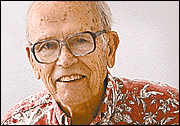Advertisement - Click to support our sponsors.


Hawaii’s World
THE dreariest of diseases are those we can't do much about and just have to suffer through. Coping with
macular degenerationI have just awakened to one of the dreariest -- macular degeneration. It starts when you think there is a smear of Vaseline in the middle of your eyeglass. It progresses to barely being able to see from that eye at all; it's legal blindness if you have it in both eyes.
I am not a sufferer, fortunately, but have six fairly close friends who are.
It isn't pushed to the forefront of our attention like AIDs, alcoholism, Alzheimer's, arthritis...and these are only the beginning of a long alphabetical list that have foundations to offer support.
There is an Association for Macular Diseases, based in New York City (more on it later), but it has few chapters west of the Mississippi, none in Hawaii.
My dictionary defines an ophthalmologist as a physician dealing with the structure, function and diseases of the eye.
Pages 862-867 of my GTE Hawaiian Tel yellow pages for Oahu, 1999-2000, list a goodly number of ophthalmologists with their ads. The word "macular" seldom appears.
There is a reason. While lasers and other surgery can do marvelous things to improve vision for many, there has been very little to do for the macular degeneration patient except commiserate and offer guidelines for dealing with blindness as it relentlessly progresses.
Macular degeneration, I'm told, is now the nation's leading cause of legal blindness, the foremost destroyer of vision among older Americans. It can start as young as 50.
It destroys straight-ahead vision. Sufferers can't drive, can't recognize people right in front of them, can't read or partake in hobbies requiring straight-ahead vision.
By age 75, 25 percent of men and 33 percent of women have developed symptoms.
Prevention help seems to come from high consumption of spinach, collards and other yellow or leafy green vegetables. At Hawaii's Natural Energy Research Laboratory in Kona a company named Aquasearch is working at growing microalgae as a useful diet supplement.
Dr. Gregg T. Kokame, of Retina Consultants of Hawaii, in Honolulu, has just taken part in restricted national testing of a photodynamic therapy dye, injected into the arm, that seems to stabilize vision loss for many patients but not cure it. Pending a recommended OK by the Federal Drug Administration it is not yet generally available.
CONGRESS funds the National Institutes of Health, which, in turn, make annual grants to the National Eye Institute with the wonderful address of 2020 Vision Place, Bethesda, MD 20892. NEI gives three-fourths of its budget to macular degeneration research but there's not the same clamor for more that has benefited AIDs, cancer and more publicized ailments.
I am skeptical that private organizations may divert too much money to fund-raising and high-living management, so am loath to recommend unfamiliar ones. But Dr. John Drouilhet, one of Hawaii's few macular specialists, tells me he contributes to Research to Prevent Blindness at 645 Madison Ave., New York, NY 10022-1010. Dr. Kokame recommends Kapiolani Health Foundation, 55 Merchant St., Honolulu, HI 96813, with which his office cooperates.
The Association for Macular Diseases will send you its quarterly newsletter, Eyes Only, and give you access to its member hot line for $20 in dues mailed to either P.O. Box 220154 at Great Neck, NY 11022-0154 or 210 East 64th St., New York, NY 10021.
A.A. Smyser is the contributing editor
and former editor of the the Star-Bulletin
His column runs Tuesday and Thursday.